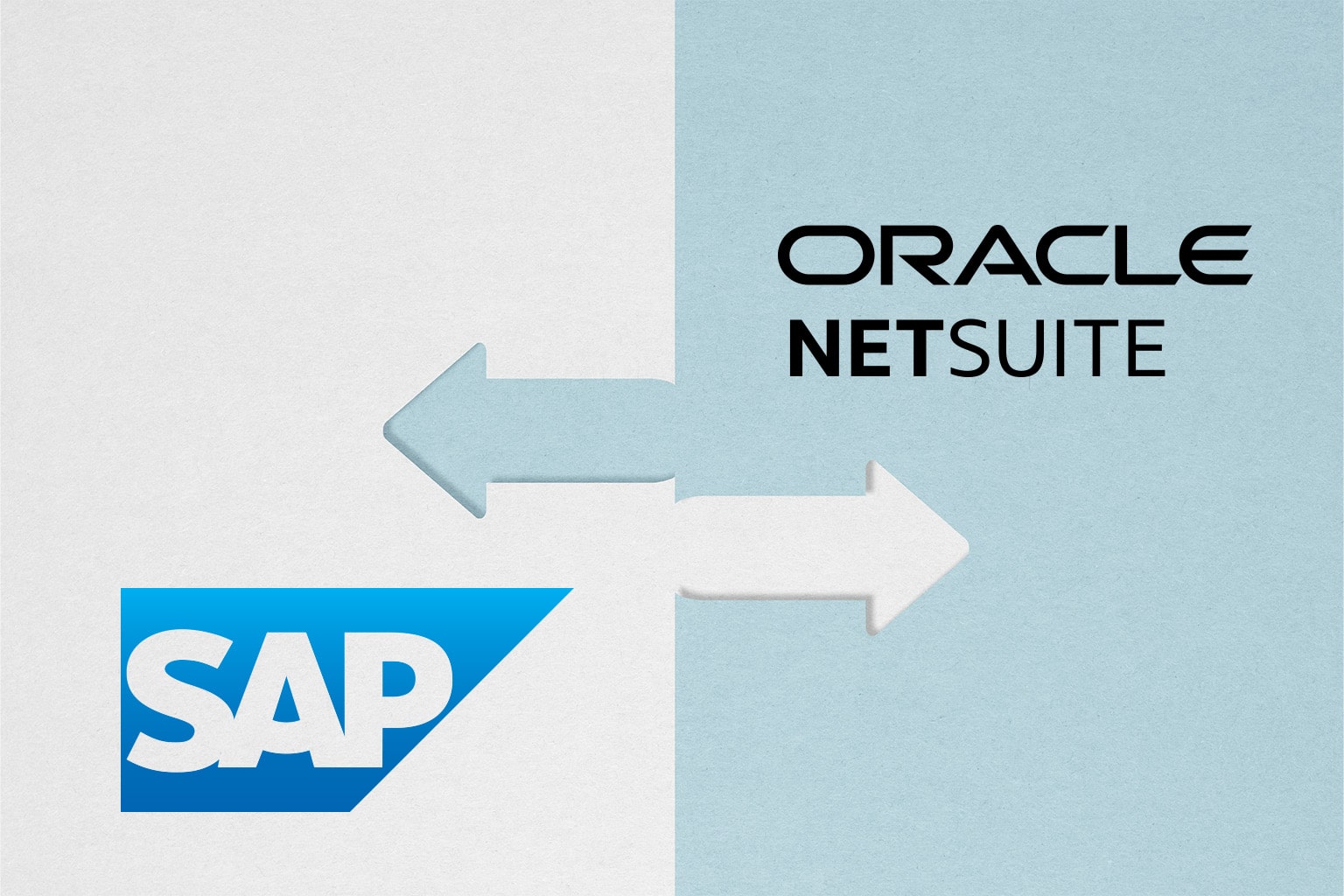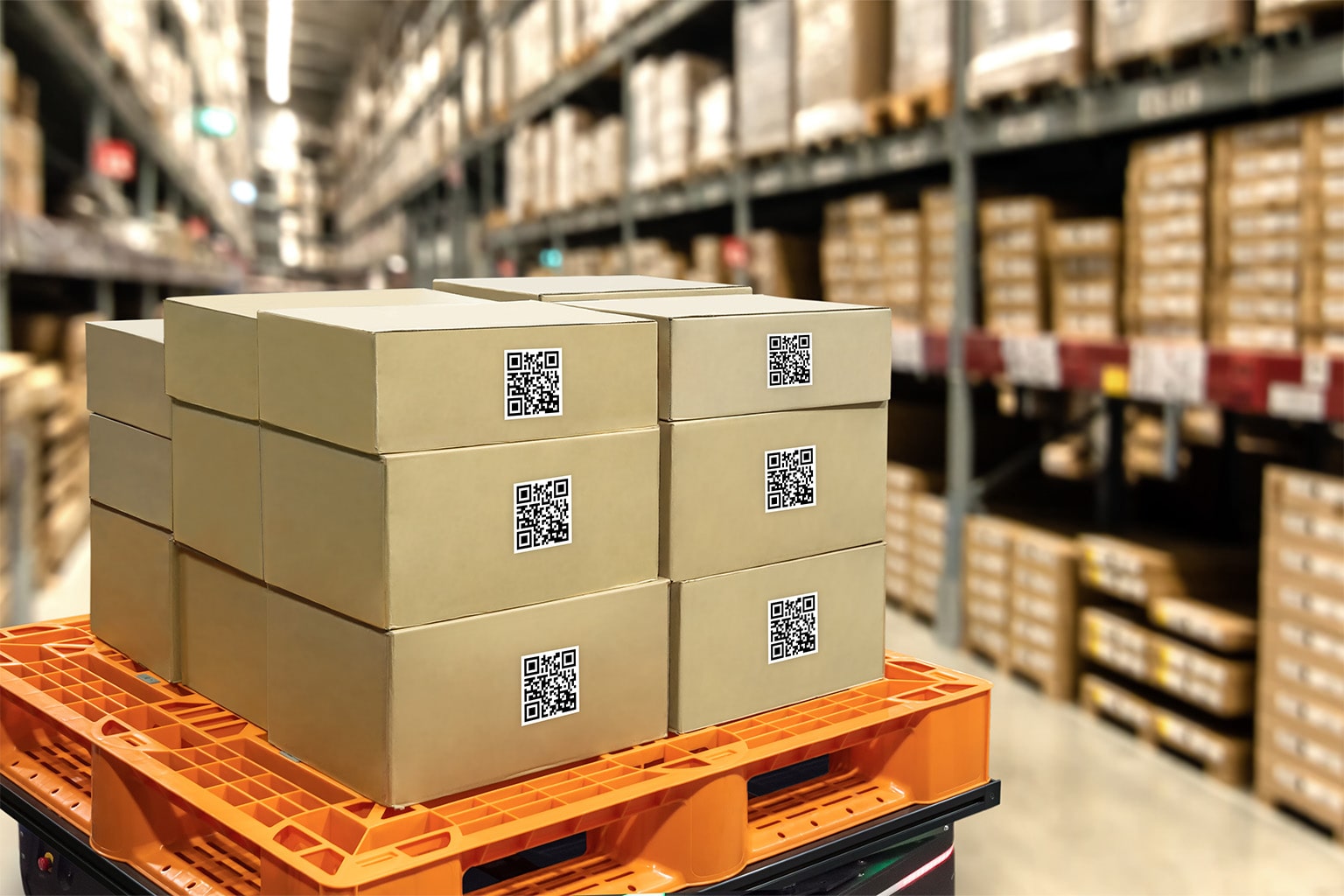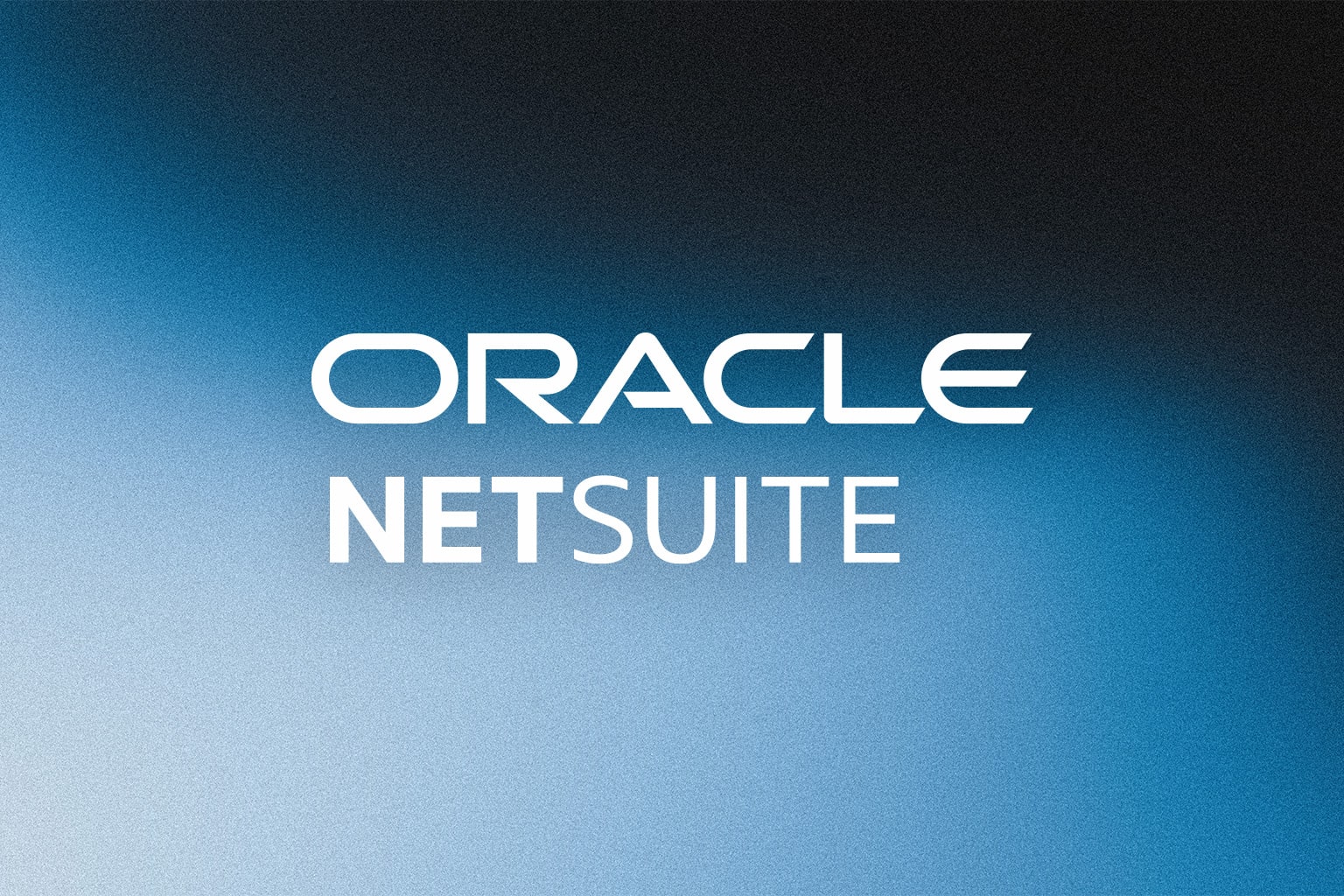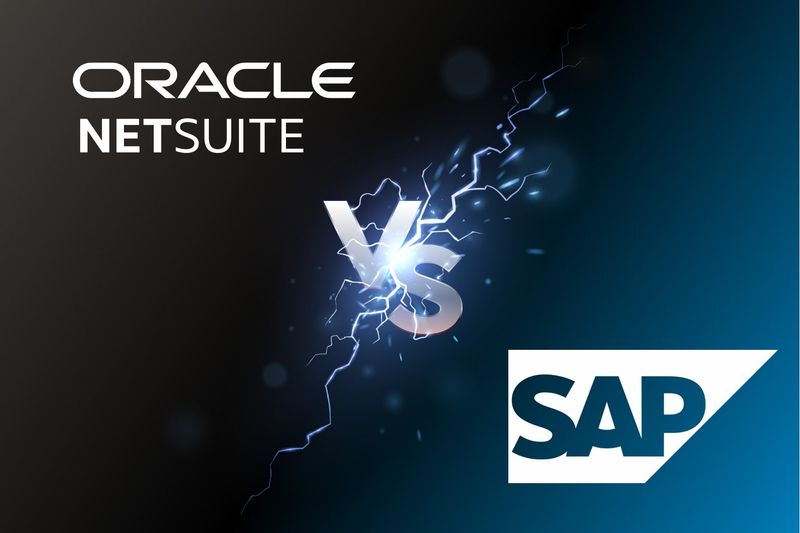Here’s the verdict: NetSuite is the best ERP option and wins over SAP ERP solutions primarily because NetSuite stands as a true cloud-only platform providing unmatched native functionality and scalability while avoiding SAP’s pitfall of confusing users with too many options.
Let’s look closely at NetSuite vs. SAP ERP side-by-side to see how NetSuite stands tallest in the ERP market.
What Exactly is an ERP?
Enterprise Resource Planning (ERP) is the software backbone of a business, especially one that’s looking to scale.
At its core, ERP software integrates all facets of an operation — including product planning, development, manufacturing, sales, and marketing — in a single database, application, and user interface. ERP systems tie together and define many of these business processes, enabling the flow of data between them.
By collecting an organization’s shared transactional data from multiple sources, ERP systems eliminate data duplication and provide data integrity with a “single source of truth.”
What’s the significance of Cloud-based ERP?

Cloud-based ERP is an ERP system hosted on a cloud computing platform rather than on-premises within an enterprise’s own data center.
The significance of Cloud-based ERP lies in its flexibility, cost-effectiveness, and ease of implementation and maintenance. Key advantages include scalability, accessibility (access from anywhere at any time), real-time data, automatic software updates, and data security.
What’s the History of NetSuite?
NetSuite, formally known as Oracle NetSuite, has a rich history that dates back to 1998 (the year it NetSuite was founded).
Evan Goldberg founded NetSuite with funding from Oracle Corporation’s executive chairman Larry Ellison. The company was originally named NetLedger, reflecting its initial focus on web-hosted accounting software. Over time, NetLedger evolved to NetSuite, moving beyond bookkeeping and accounting, touching on many aspects of business operations.
NetSuite’s growth continued steadily over the years, and it became known as a pioneer in the cloud computing space. In November 2016, Oracle Corporation acquired NetSuite, further solidifying its position in the market.
Today, NetSuite is globally recognized as a leading provider of cloud-based ERP solutions, serving over 36,000 businesses of all sizes across a wide range of industries.
Its integrated platform allows companies to manage their core business processes efficiently, providing real-time access to crucial business data, advanced analytics, automation features, and the ability to customize the system according to specific needs.
What’s the History of SAP?
SAP ERP dates back to 1972 when five former IBM engineers — Dietmar Hopp, Hasso Plattner, Claus Wellenreuther, Klaus Tschira, and Hans-Werner Hector — founded the company in Weinheim, Germany. SAP stands for “Systeme, Anwendungen und Produkte in der Datenverarbeitung,” which translates in English to “Systems, Applications, and Products in Data Processing.”
As IBM’s mainframe software did, the founders aimed to create software that could process data when the user wanted rather than in overnight batches. Their first product was a financial accounting software suite that included modules for sales and distribution, materials management, and production planning.
The most recent version of SAP is S/4HANA, launched in 2015. It is intended to be easier to use and administer while solving more complex problems and handling vastly larger amounts of data than its predecessors. It can run on-premise, in the cloud, or a combination of both.
What’s the Biggest Difference Between NetSuite and SAP ERP?

There are three major differences between NetSuite and SAP’s family of ERP products:
- Product offerings
- Native functionality
- Stability
NetSuite Is Exclusively Cloud-Based
The primary distinction between NetSuite and SAP lies in their product offerings.
NetSuite provides a single cloud-based ERP solution. That’s it—no need to navigate various ERP packages and risk buyer’s remorse.
By contrast, SAP offers three separate systems: SAP S/4HANA Cloud, Public Edition; SAP Business One; and SAP Business ByDesign. Each system has overlapping features but targets different market segments and industry verticals, which can paralyze customers when selecting an ERP.
Plus, unlike NetSuite, SAP requires an expensive staff, like specialized IT, to run it in an organization.
NetSuite Has More Out of the Box
NetSuite provides a comprehensive suite of integrated business management applications that cover various functionalities, including financial management, inventory management, order management, CRM, ecommerce, human resources, and more.
These pre-integrated applications enable seamless data flow and process automation across different departments.
On the other hand, SAP requires businesses to select and implement individual applications for specific functionalities and requires more customization and integration efforts — potentially misaligning data.
Another sticking point for SAP is that their products are often called a “data vault,” meaning it’s great at capturing data. Still, users find it challenging to access the data for reporting and analytics.
NetSuite is Here to Stay
With a single solution, Oracle NetSuite is fundamentally built for now and the future. With SAP, you run the risk of its past digressions: Will your version of SAP ERP be sunsetted, forcing you to onboard and adopt an unfamiliar system?
Take a look at SAP’s history of product shifts requiring new training and upgrades:
In 1973, SAP launched its first commercial product, an enterprise resource planning (ERP) system called R/1 (R stands for “real-time data processing”). It was a one-tier architecture where presentation, applications, and data were on the same server.
In 1979, SAP launched R/2, a mainframe system that supported different languages and currencies. This version marked the company’s entry into the global market.
In 1992, SAP introduced R/3, a client-server version that included modules covering finance, controlling, asset management, quality management, production planning, sales and distribution, human resources, and project management.
In 2004, SAP released SAP ERP Central Component (ECC) 5.0. Nearly four years later, they released ECC 6.0.
The latest lineup of SAP products includes SAP S/4HANA Cloud, Public Edition, SAP Business One, and SAP Business ByDesign. It’s not easy to choose from the names what version you should choose or whether or not one of these versions will be sunsetted. As of this writing, SAP is closing SAP ERP (also known as SAP ECC).
Feature Comparison: NetSuite vs. SAP S/4HANA Cloud, Public Edition

The confusion starts with SAP S/4HANA, offering four versions: two on-premises and two cloud-based solutions. Right away, you run the risk of selecting the wrong version. Sales reps often blur the distinction between each product to fast-track a sale rather than providing clarity and a solution that’s best for your business.
Before selecting NetSuite, many customers considered SAP S/4HANA Cloud, Public Edition a potential alternative, so we’ll focus on this version for our feature comparison.
Baseline Technology
The S/4HANA Cloud, Public Edition natively supports financial management and other departments. However, part of its financial software is based on old technology, so you might need more apps to handle all your tasks. Unlike NetSuite, S/4HANA doesn’t have built-in customer relationship management (CRM) and data analysis features.
Even if you’re not a tech whiz, you can easily learn how to use NetSuite to create reports on business data and customize dashboards. NetSuite also includes tools for managing inventory, orders, CRM, buying supplies, and tracking expenses.
If you need more features, you can add NetSuite modules for areas like human capital management (HCM), financial planning, project service automation (PSA), advanced analytics, online selling, and others.
Pushing Software Updates
From an IT perspective, S/4HANA Cloud, Public Edition requires you to install two annual updates — forcing the issue of testing against your system and making critical decisions every year on what works and what doesn’t. With NetSuite, you can test its semiannual performance upgrades in a test environment even before the new features are released. Stay ahead without the fear of breaking your system.
Customization

You have to rely on SAP partners to make customizations meaning adding another vendor to your accounts payable. Even then, SAP S/4HANA Cloud, Public Edition, has guardrails on custom development. Simply put, you can only use SAP-approved APIs with SAP S/4HANA Cloud, Public Edition.
With NetSuite, you can integrate new modules, build unlimited custom records, and configure user-friendly drag-and-drop workflows to fit the needs of your business — all without touching a line of code. And when you need advanced support, you can connect with certified NetSuite Solutions Providers to augment your instance without messing with its core functions.
Understanding “Grow with SAP” vs. NetSuite
Grow with SAP is a strategic offering to new customers designed to help midsize businesses adopt S/4HANA Cloud, Public Edition, with SAP’s Business Technology platform. You’ll need to qualify by earning $100 million or more in revenue to use Grow with SAP.
It touts a speedy path to go live with SAP S/4HANA Cloud, Public Edition, but little data and a small number of customers have yet to prove it to be a reliable model quite yet. NetSuite, however, has thousands of implementations under its belt and a library of success stories to boot.
Understanding “Rise with SAP” vs. NetSuite
To complicate analysis paralysis with SAP even further, SAP offers “Rise with SAP” as another bundle for large customers to migrate to the cloud. This initiative wasn’t successful. Furthermore, it relies on outside hosting companies and service vendors to build on its base system.
With NetSuite, you have no confusion over who houses the data, hosting, and software — it’s all NetSuite, period.
Feature Comparison: NetSuite vs. SAP Business One (B1)
SAP Business One (B1) is billed as the entry-level solution to SAP. However, its low initial prices can unpredictably compound over time and create barriers to scale in a short time. To add to the complexity, It offers both an on-premises and cloud-based solution.
Financial Management
SAP Business One (B1) can handle basic financial tasks but hits its limits. For example:
- Requires separate databases to process international transactions
- It doesn’t allow accountants to edit or remove financial transactions
- Lack of automation for fixed asset depreciation
Conversely, NetSuite provides tools and automation for multiple countries, currencies, and fixed asset management through the following depreciation and costing methods:
- Straight-Line Depreciation
- Declining Balance Depreciation
- Sum-of-the-Years Digits (SYD)
- Average Cost
- First In, First Out (FIFO)
- Last In, First Out (LIFO)
- Specific Identification
Supply Chain Management

SAP Business One has inventory and materials management tools but struggles with the following:
- No native offering for Warehouse management (WMS)
- Limited demand planning
- Requiring 3rd party integrations (and additional spending) to achieve the above
You can build your NetSuite instance to fully function across the supply chain, including:
- Data management
- Warehouse management
- Inventory management
- Order/supply/sourcing management
- Transportation management
- Collaboration tools
- Production management
- Demand planning
- WIP & routing
- Work orders & assemblies
- Shop floor control
- BOM maintenance
Analytics, Reporting, and Dashboards
Business One struggles with streamlined reporting. It needs to gather data from several sources to amass data into actionable insights. You can build custom reports with the help of consultants or developers; in other words, more billable hours.
NetSuite allows decision-makers to view real-time data at a high level with completely customizable dashboards or drill down to the granular details across the entire organization.
Baseline Technology
Make no mistake, Business One is not cloud-based. You need to partner with a hosting service provider like AWS or Microsoft Azure to store the software — so stack on another bill and another dependency to run SAP Business One.
Plus, you don’t get automatic upgrades with SAP Business One. Instead, you receive quarterly feature packs that are left to your discretion. This potentially can mean that your organization runs multiple instances with different versions of SAP, causing fractured data and manual mixes.
Business One customers can quickly hit their function capacities, requiring a shift to S/4 HANA. Instead, NetSuite offers a modular approach, allowing companies to add features as they grow, seamlessly transforming their business to meet the latest growth demands.
A Note on SAP ByDesign
Despite being a true SaaS product (like NetSuite), SAP ByDesign is currently in its end-of-life stages. It never took off as expected, customers reported numerous issues, and its capabilities fell way short of NetSuite ERP.
Don’t Overlook Implementation

Once you’ve made an ERP selection, implementation is the next critical step. Who will you choose to help you and your team fully utilize the new ERP? Let’s take a look at two different approaches by SAP ERP and NetSuite.
SAP S/4HANA Cloud, Public Edition, Business One, and even ByDesign all relied on 200+ partners to go live. The variance in quality, methodology, and efficiency is great — there’s no telling what you’ll get. Projects are billed on time and materials, so implementation costs can get out of hand before you know it.
Comparably, NetSuite has curated a network of professionals specializing in a region or business vertical. NetSuite Solutions Providers bring institutional knowledge to specific industries to personalize your implementation experience and keep your best interest in mind.
Final Word: Why NetSuite Wins Over SAP ERP

It’s hard enough to run and grow a business, so selecting an ERP shouldn’t be overwhelming. SAP’s family of products creates confusion, presenting old-fashioned on-premise ERP options with cloud-based and hybrid solutions overcomplicating everything.
NetSuite is a true cloud-based ERP with modular options to fit your business goals best. Pay for what you need, and skip the rest. Avoid the noise, and level up with a tried and tested platform powering over 30,000 customers of all-sized businesses across the world.
If you’d like a customized demo, book a call with our NetSuite specialists at StratusGreen. We bring a white-glove approach to helping our customers succeed — considering your unique goals and team in everything we do.



